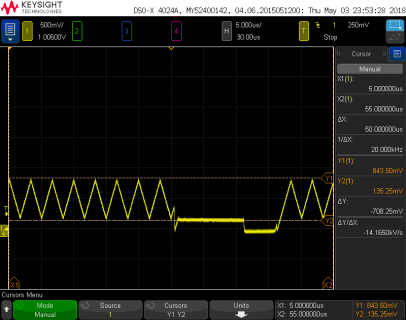Gerhardus1
New member
Hello,
I intend to use the touchRead() functionality with Teensy 3.2 to read capacitance values. One "plate" of the capacitor will be grounded, and the other will be connected to the chosen pin on the Teensy.
From my understanding of how touchRead() works, the Teensy will use onboard hardware to charge/discharge the chosen pin through some pre-determined voltage range. After some number of cycles or some elapsed time, the Teensy will then repeat the same cycle with an onboard 1pF reference capacitor and then output the ratio of reference capacitor cycles to pin cycles. Is this an accurate understanding of the touchRead() functionality?
My questions are as follows:
What voltage range relative to ground does the Teensy cycle the pin through? If it is different, what voltage range does the Teensy cycle the reference capacitor through?
The Teensy will potentially experience extreme temperature changes. Is there any data available for the impact of variable temperature on the Teensy?
Does the read time or output scale linearly with any given capacitance change or resistance change on the pin (the assumption is that resistance will be in series with the capacitor, and not distributed throughout the capacitor)?
Reading through the forum, I have found a few posts indicating that errors of less than 20pF are readily achievable, and an error of 1pF or less could be theoretically obtained if a large M-ohm-range resistor was put between the active element of the capacitor and the Teensy pin. Unfortunately, I am now unable to find those posts. That said, how accurate can touchRead() get? Note that the setup can be calibrated for its specific components and operating conditions.
The connection from the Teensy to the capacitor will be via a significant length of coaxial cable which will also be subject to temperature changes and consequent capacitance changes. To correct for the unknown and variable capacitance of the cable in real time, would it be reasonable to run an identical cable alongside it which is not connected to a capacitor, and measure its capacitance with another pin? The value of the capacitance of the parallel cable can be subtracted from the reading from the cable-capacitor assembly in real-time to eliminate the effect of the variable capacitance of the cable. The delay between the reading of each cable should not have a significant impact. Is this a valid line of reasoning?
Thanks in advance for the information.
I intend to use the touchRead() functionality with Teensy 3.2 to read capacitance values. One "plate" of the capacitor will be grounded, and the other will be connected to the chosen pin on the Teensy.
From my understanding of how touchRead() works, the Teensy will use onboard hardware to charge/discharge the chosen pin through some pre-determined voltage range. After some number of cycles or some elapsed time, the Teensy will then repeat the same cycle with an onboard 1pF reference capacitor and then output the ratio of reference capacitor cycles to pin cycles. Is this an accurate understanding of the touchRead() functionality?
My questions are as follows:
What voltage range relative to ground does the Teensy cycle the pin through? If it is different, what voltage range does the Teensy cycle the reference capacitor through?
The Teensy will potentially experience extreme temperature changes. Is there any data available for the impact of variable temperature on the Teensy?
Does the read time or output scale linearly with any given capacitance change or resistance change on the pin (the assumption is that resistance will be in series with the capacitor, and not distributed throughout the capacitor)?
Reading through the forum, I have found a few posts indicating that errors of less than 20pF are readily achievable, and an error of 1pF or less could be theoretically obtained if a large M-ohm-range resistor was put between the active element of the capacitor and the Teensy pin. Unfortunately, I am now unable to find those posts. That said, how accurate can touchRead() get? Note that the setup can be calibrated for its specific components and operating conditions.
The connection from the Teensy to the capacitor will be via a significant length of coaxial cable which will also be subject to temperature changes and consequent capacitance changes. To correct for the unknown and variable capacitance of the cable in real time, would it be reasonable to run an identical cable alongside it which is not connected to a capacitor, and measure its capacitance with another pin? The value of the capacitance of the parallel cable can be subtracted from the reading from the cable-capacitor assembly in real-time to eliminate the effect of the variable capacitance of the cable. The delay between the reading of each cable should not have a significant impact. Is this a valid line of reasoning?
Thanks in advance for the information.


